Source: 4th World Junior Bridge Camp Insko 9-16 July 2001 This Mark Horton’s lecture is based on his book, Step by Step Signalling, a part of the Better Bridge Now! series as Better Signalling Now!
This Mark Horton’s lecture is based on his book, Step by Step Signalling, a part of the Better Bridge Now! series as Better Signalling Now! 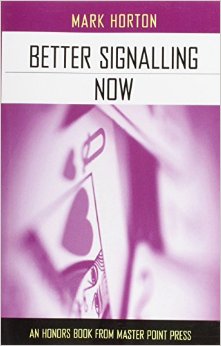
It was at the battle of Copenhagen that Nelson, on being instructed to disengage the enemy, put his telescope to his blind eye and said ‘I see no signal’.
While most bridge players have excellent eyesight it’s remarkable how often they ask partner, ‘Didn’t you see my signal?’
There are three basic signals you might wish to give:
Count, where you tell partner how many cards you have in a suit.
Attitude, where you tell partner if you like their lead.
Suit Preference, where you try and tell partner which suit to switch to. Let’s look at a particular situation:  This deal is from the 1978 World pairs Olympiad. The simple looking problem is for East/West to defeat 3NT. Can we establish that our methods are good enough to allow us to do this? Imagine for example you led the ace of spades and partner played an encouraging nine. Now what? Could partner have
This deal is from the 1978 World pairs Olympiad. The simple looking problem is for East/West to defeat 3NT. Can we establish that our methods are good enough to allow us to do this? Imagine for example you led the ace of spades and partner played an encouraging nine. Now what? Could partner have ![]() Q97? You begin to see the problem? If the ace of spades asks for count, there should not be a problem. Can you see why?
Q97? You begin to see the problem? If the ace of spades asks for count, there should not be a problem. Can you see why?
The answer to this type of problem is to be able to choose which signal you would like to receive from partner. So the suggestion, one used by almost all top players, is that the ace asks for attitude, and the king for count. Can you think of a way this might be extended to another honour combination? You could agree to lead the queen from KQ, with the idea that the queen asks for attitude. Lets look at a few situations: 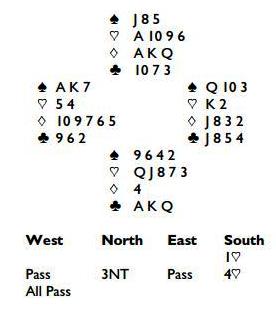 You will not always be so fortunate as to have an ace-king combination to lead from but when you do it will generally be an automatic choice. Which card should you lead? lead? Here the ace of spades should fall out of your hand! You don’t need to know how many spades partner has, but you do need to know if he likes the suit. What card should East play? The ten of spades, letting West know you like the lead. Now you get three spade tricks and must score a trump trick later. Imagine the East’s holding had been
You will not always be so fortunate as to have an ace-king combination to lead from but when you do it will generally be an automatic choice. Which card should you lead? lead? Here the ace of spades should fall out of your hand! You don’t need to know how many spades partner has, but you do need to know if he likes the suit. What card should East play? The ten of spades, letting West know you like the lead. Now you get three spade tricks and must score a trump trick later. Imagine the East’s holding had been ![]() Q32. What card should he play then? The three is the best you can do. Maybe partner will notice the two is missing. How would you approach this problem:
Q32. What card should he play then? The three is the best you can do. Maybe partner will notice the two is missing. How would you approach this problem:
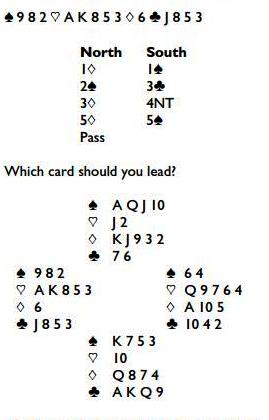 The king of hearts will get a count signal from partner. Once you realise that South would not have used Blackwood with two losing hearts it should be easy enough to switch to a diamond.
The king of hearts will get a count signal from partner. Once you realise that South would not have used Blackwood with two losing hearts it should be easy enough to switch to a diamond. 
Which Club should West lead? The king. This may well be a cash out situation, so you need to know how many clubs your partner has. Which card should East play at trick one? The ten of clubs — always signal with the clearest card you can afford. What should West switch to? Only a spade will do the trick for the defence. You simply have to hope declarer started with a doubleton spade. This next one is difficult! 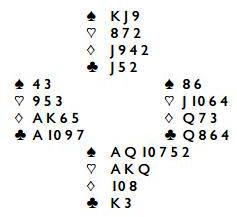
South is in Four Spades after 1![]() -2
-2![]() -4
-4![]() . Do not let your knowledge of signals cause you to stop thinking! What should West lead? The ace of diamonds. What card should East play? Suppose you play an automatic encouraging seven? Partner may now play you for a doubleton, rather than
. Do not let your knowledge of signals cause you to stop thinking! What should West lead? The ace of diamonds. What card should East play? Suppose you play an automatic encouraging seven? Partner may now play you for a doubleton, rather than ![]() Qxx. If he plays the
Qxx. If he plays the ![]() K next, declarer will be able to set up a diamond for a club discard. You have to be passive and play the three of diamonds. As long as partner does not do anything foolish you will eventually score four tricks. The final deal illustrates a number of signals and sees one of the world’s top pairs, Jeff Meckstroth and Eric Rodwell on the receiving end of a hot defence.
K next, declarer will be able to set up a diamond for a club discard. You have to be passive and play the three of diamonds. As long as partner does not do anything foolish you will eventually score four tricks. The final deal illustrates a number of signals and sees one of the world’s top pairs, Jeff Meckstroth and Eric Rodwell on the receiving end of a hot defence. 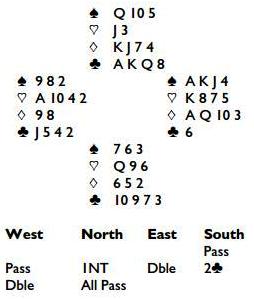
A classic combination of signals on one deal. What should West lead? The nine of diamonds is the obvious choice, hoping for a ruff or two. What should East play at trick two? The king of spades. That lets partner know what to do when he gets in with a diamond ruff. What card should West play at trick two? The two of spades to show an odd number. Now East will cash the ace of diamonds and play back a diamond for West to ruff. If West gets a diamond ruff, what card should he return? The nine of spades, hoping partner will read it as a suit preference signal. What should East do then? After cashing two spade tricks, East should play a low heart. West wins and returns the suit and after taking his sides second heart trick East plays his last diamond, enabling West to score the jack of clubs.
